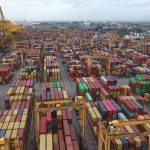In one of the first instances of an oil tanker transporting Southeast Asia-bound crude through the Suez Canal following the Israel-Hamas ceasefire agreement, trade is gradually picking up, according to S&P Global Commodities at Sea(opens in a new tab) and market participants Jan. 23.
The restoration of normal shipments through the Suez Canal is expected to happen sooner rather than later. At least one tanker has already passed through with Singapore-bound crude, and market participants said this will soon become a more frequent trend.
The Singapore-bound Neptune I is currently sailing south of the Gulf of Suez after passing through the Suez Canal, with an estimated arrival in Singapore on Feb. 8, according to CAS as of around 0900 UTC (0900 GMT).
The Panama-flagged and 2004-built Neptune I Aframax tanker is operated by Greece’s Sea Trade Marine, according to CAS.
The LPG carrier Rayyan Gas, operated by Mphasis Marine Solutions FZE, is sailing southward through the Red Sea after transiting the Suez Canal and is estimated to arrive in Khor Fakkan in the UAE on Feb. 1, according to CAS.
The VLCC Ghazal, operated by Saudi shipping company Bahri, is also sailing southward through the Red Sea after loading a crude cargo in Yanbu and is estimated to arrive in Onsan, South Korea, on Feb. 15, according to CAS.
“It’s nothing out of the ordinary … A regular light sour crude supply from the parent company Aramco,” said a feedstock management source at South Korean refiner S-Oil based in Onsan.
S-Oil, which is 63.4% held by Aramco Overseas, a subsidiary of Saudi Aramco, runs three crude distillation units — No. 1 with 90,000 b/d, No. 2 with 240,000 b/d and No. 3 with 250,000 b/d, as well as a condensate fractionation unit with a capacity of 89,000 b/d, which brings its total refining capacity to 669,000 b/d in Onsan.
However, Asian refiners, particularly in South Korea and Thailand, remain hesitant to import Mediterranean crudes, especially CPC Blend, due to ongoing security concerns regarding tanker passage through the Red Sea amid geopolitical tensions. The recent Israel-Hamas ceasefire has not alleviated fears of potential attacks on ships, leading to high shipping insurance costs and a lack of confidence in safe transit, refinery sources told S&P Global Commodity Insights previously.
Consequently, the crude must take the longer and more expensive Cape of Good Hope route, rendering it economically unviable. As a result, South Korea’s CPC Blend imports have plummeted by 63% in the latter half of 2024 compared with the previous year, while Thai refineries have largely turned away from this crude due to its limited role in their feedstock strategies.
Platts, part of Commodity Insights, assessed CPC Blend on a CIF Augusta basis at a discount of $3.7/b to the Dated Brent strip on Jan. 22. The discount has averaged $1.84/b so far in January, compared with an average discount of 88 cents/b in December 2024.
High risk
Previously, only a small number of tankers, mostly owned by Greeks and companies controlled by refiners in the Persian Gulf, were passing through the Red Sea due to the risk of attacks by the Houthi rebels. However, after the rebels announced a promise not to attack most ships, confidence among shipping entities appears to be gradually restoring.
Although normalcy in Suez Canal transit has not yet been fully restored, the positive sentiment has led to a significant decline in freight rates.
In another instance, Naftomar’s LR1, the Silverlight, was placed on subjects by Kuwait Petroleum Corp. at $2.9 million for Jan. 31 jet fuel loading on the Kuwait-to-UK-Continent route via the Suez Canal, according to market sources.
Such instances are expected to increase in the coming weeks, a broker in Singapore said.
Although the Red Sea and Bab al-Mandab Strait are still designated as high-risk areas by Lloyd’s Joint War Committee, charterers are now pushing for a lower additional war risk premium (AWRP). However, cargo insurance premiums remain the same as they were prior to the ceasefire, according to an insurance broker.
With the commencement of the Israel-Hamas ceasefire deal on Jan. 19, the Iran-backed Houthi fighters pledged to cease attacking ships passing through the Red Sea except for those flagged in Israel or wholly owned by Israeli companies or individuals.
Oil transits via the Bab al-Mandab Strait at the southern end of the Red Sea fell to 2.5 million b/d in 2024 from 6.9 million b/d in 2023, while those via the Suez Canal — which connects the Red Sea and the Mediterranean — dropped to 3.9 million b/d from 7.9 million b/d, according to CAS.
LNG ship transit via the Red Sea and through the Suez Canal has been halted for more than a year due to increased attacks on merchant ships.
Source: Platts





